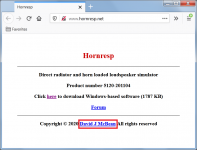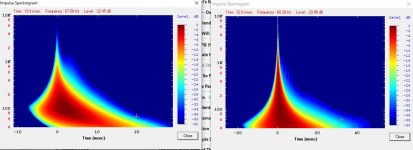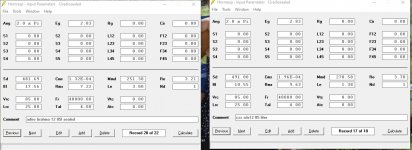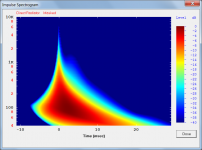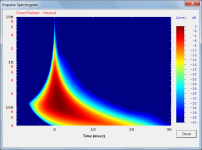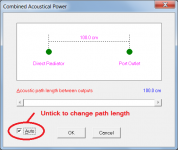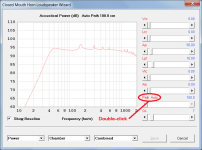Didn't i catch at least a bit of your interest David ?
Not in the slightest. It is my sad duty to report that the Grinch has decided there will be no Hornresp presents for you this Christmas... 🙂.
Attachments
Didn't you trapped yourself with a re-entrant trap and you'll be too out of phase soon : the grinch become kind at the end, nope ?
🙂
PS : I welcome your epic forum answer. Each time you give us a view of your wit is a gift on his own ("wit" : expecting good use of this google translate word ^^)
🙂
PS : I welcome your epic forum answer. Each time you give us a view of your wit is a gift on his own ("wit" : expecting good use of this google translate word ^^)
David, can you email me about using Hornresp in a commercial aspect? I'm considering selling designs.
the grinch become kind at the end
True, but the McGrinch doesn't - even after being trapped in a re-entrant trap 🙂.
I'm considering selling designs.
Hi Etocynned,
Not a problem, you can use Hornresp any way that you would like to. Thanks for taking the trouble to check with me first, though. I know of a number of businesses who are using Hornresp to simulate / design loudspeakers that they sell commercially, but have not bothered to ask me if it is okay for them to do so 🙂.
If you still wish to send me an email, simply click on my name on the Hornresp download page, as shown in the attachment.
Kind regards,
David
Attachments
That's wrong for them to not pay you a fee.
Hi BP1Fanatic,
It's fine by me that they don't pay a fee, but it would have been nice of them to have sought permission to use Hornresp for commercial purposes before starting out. It is only common courtesy, after all. Perhaps I am being a bit old-fashioned in thinking this way - showing my age... 🙂.
It's hard to believe, but in the early days I had people actually putting copies of Hornresp on their own websites for downloading, with no acknowledgement of where the software was sourced from, implying that it was something that they or their company had developed. Thankfully this practice now seems to have ceased. The problem was, Hornresp was being updated so often that the copies they were offering very quickly became out of date. Also, I couldn't guarantee that the copies they were making available had not been hacked in some way.
Kind regards,
David
What’s the most interesting or curiously complex speaker designed and simulated using Horn Response?
The compound horn/pipe varieties or any gigantic ‘near perfect bass horns expanding shaped paths to ambient??
A tapped and offset chambered, mass loaded Venturi shaped collection of chaos and random uses of many acoustical shapes to a beautiful disaster?
😀
There’s gotta be a few bizarre and unique eye brow raisers over the years, or twisted and contorted ideas that somehow combined in a result that surprisingly worked out? anyone surprise you with pushing the edges of ? crazy but fun. i think you should start billing me for having to read my questions, haaaaa, thanks for keeping it interesting!.
The compound horn/pipe varieties or any gigantic ‘near perfect bass horns expanding shaped paths to ambient??
A tapped and offset chambered, mass loaded Venturi shaped collection of chaos and random uses of many acoustical shapes to a beautiful disaster?
😀
There’s gotta be a few bizarre and unique eye brow raisers over the years, or twisted and contorted ideas that somehow combined in a result that surprisingly worked out? anyone surprise you with pushing the edges of ? crazy but fun. i think you should start billing me for having to read my questions, haaaaa, thanks for keeping it interesting!.
Last edited:
Multiple-entry horns.
Maybe
Eventually I
Hope
(Someday)... looks intimidating!
David and friends, I have a question about interpreting the impulse spectrogram. The attached screen capture is a comparison of two 12" subwoofers in a 85 liter box. What causes the one on the left to have a rightward tilt at low frequencies? Is this group delay or a slower rise time? Thanks.
Attachments
What’s the most interesting or curiously complex speaker designed and simulated using Horn Response?
The most complicated Hornresp simulation model mathematically, is the one used to analyse three-way multiple entry horns. It solves 14 simultaneous equations to find the values of 14 unknown complex variables having both real and imaginary components.
What causes the one on the left to have a rightward tilt at low frequencies?
Your guess is as good as mine 🙂.
Posting the input parameter values for the two systems would perhaps help people to identify the reason and provide an answer your question.
basically just two long throw sealed 12" subwoofers.
Just wondering what can be learned by the dark red trailing off to the lower right on the left picture. Is this a slow rise time or a slow decay? The impulse spectrum is basically a top view of a CSD correct?
Just wondering what can be learned by the dark red trailing off to the lower right on the left picture. Is this a slow rise time or a slow decay? The impulse spectrum is basically a top view of a CSD correct?
Attachments
basically just two long throw sealed 12" subwoofers.
Allowing for the small offset in time scales, the impulse spectrogram results for your two given examples would appear to be quite similar (see attachments).
Just wondering what can be learned by the dark red trailing off to the lower right on the left picture.
The impulse spectrogram algorithm used in Hornresp was developed by Jean-Michel Le Cléac'h. He very kindly made his MATLAB code available to me because he believed that the spectrogram feature would prove to be a useful addition to Hornresp. I simply converted his code to Visual Basic for inclusion in Hornresp, making sure that I could replicate the results that he was getting. His algorithm is very elegant, but complex enough that I never really understood the theory behind it or how to fully interpret the results it produces. Jean-Michel was exceptionally gifted when it came to developing such things and I trusted his work completely. If he was still with us he would no doubt be able to answer your question immediately.
I have been assuming that people far more knowledgeable than myself on such matters, and ideally with practical experience, would know how to interpret the impulse spectrogram results and would be able to respond to your questions far more competently than I can.
The impulse spectrum is basically a top view of a CSD correct?
The impulse spectrogram is in effect a "top view" 2-D representation of the equivalent 3-D waterfall plot.
Attachments
Hornresp Update 5120-201115
Hi Everyone,
CHANGE
Previously the acoustic path length for a system with an offset driver and offset port or passive radiator was calculated automatically and could not be altered. The length value can now be changed manually if required, as shown in the attachments.
Posts #11293 and #11300 refer.
Kind regards,
David
Hi Everyone,
CHANGE
Previously the acoustic path length for a system with an offset driver and offset port or passive radiator was calculated automatically and could not be altered. The length value can now be changed manually if required, as shown in the attachments.
Posts #11293 and #11300 refer.
Kind regards,
David
Attachments
David and friends, I have a question about interpreting the impulse spectrogram. The attached screen capture is a comparison of two 12" subwoofers in a 85 liter box. What causes the one on the left to have a rightward tilt at low frequencies? Is this group delay or a slower rise time? Thanks.
I think this is a sort of wavelet analysis, there's a thread on that here: Help on making MULTIRESOLUTION WAVELET ANALYSIS available ? and an interesting piece of software for Gnu Octave was developed by DIYaudio member Elias. His website may have some useful info: http://elias.altervista.org/html/Easy_Start_on_Wavelets.html
- Home
- Loudspeakers
- Subwoofers
- Hornresp

